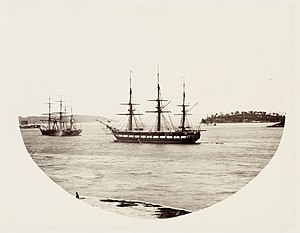
HMS Challenger was a Pearl-class corvette of the Royal Navy launched on 13 February 1858 at the Woolwich Dockyard. She served the flagship of the Australia Station between 1866 and 1870.

HMS Mildura was a Pearl-class cruiser built for the Royal Navy in the late 1880s. Originally named HMS Pelorus, she was renamed after an Australian town in April 1890. Per the Imperial Defense Act of 1887, she served primarily in Australian waters.

HMS Nile was a two-deck 90-gun second-rate ship of the line of the Royal Navy, launched on 28 June 1839 at Plymouth Dockyard. She was named to commemorate the Battle of the Nile in 1798. After service in the Baltic Sea and the North America and West Indies Station, she was converted to a training ship and renamed HMS Conway, surviving in that role until 1953.
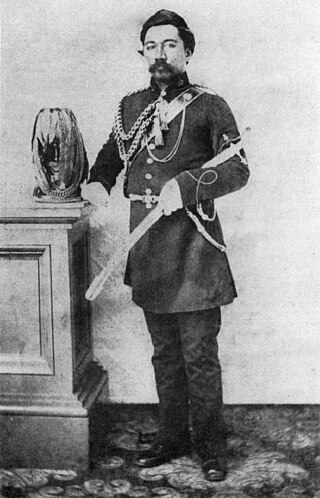
Peter Young Kaʻeo Kekuaokalani was a Hawaiian high chief (aliʻi) and politician of the Kingdom of Hawaii. His cousin was Emma, who contended for the throne after the death of Kamehameha. After being diagnosed with leprosy, he was exiled in 1873 to Kalaupapa, the isolation settlement on Molokaʻ. He was later permitted to return to Honolulu, where he died.
Hiram Kahanawai, also known as Hairama Kahanawai, was a member of the Hawaiian nobility who served as a retainer and household steward of King Kamehameha IV and his widow Queen Emma of Hawaiʻi. He married the future Princess Poʻomaikelani, and they joined the court of King Kalākaua after he won the royal election of 1874 against Queen Emma.

HMS Niger was originally slated to be built as a Sampson designed sloop; however, she was ordered as a First-Class sloop with screw propulsion on 20 February 1845 to be built at Woolwich Dockyard, along the design developed by Oliver Lang and with a hull like the Basilisk designed paddle sloops. Her armament and engine were to be like the Encounter Design building at Pembroke. A second vessel (Florentia) was ordered on 26 March 1846 but after her keel was laid at Pembroke Dockyard, her construction was suspended on 6 October 1846 then cancelled three years later, on 22 May 1849. Niger She conducted important propulsion trials, finally proving the superiority of screw propulsion and served in West Africa, the Crimea, China, the East Indies and Australia. She took part in the New Zealand wars in 1860 and was sold for breaking in 1869.
HMS Elk was a 482-ton displacement, 16-gun Acorn-class brig-sloop of the Royal Navy launched on 29 September 1847 from the Chatham Dockyard.
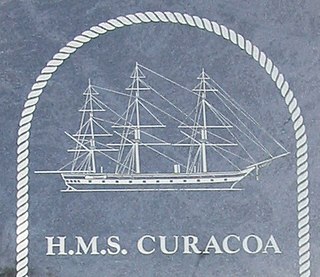
HMS Curacoa was a 31-gun Tribune-class screw frigate launched on 13 April 1854 from Pembroke Dockyard.

HMS Hecate was a 4-gun Hydra-class paddle sloop launched on 30 March 1839 from the Chatham Dockyard.
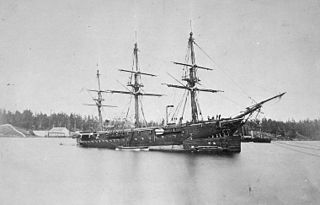
HMS Charybdis was a 21-gun Royal Navy Pearl-class corvette launched on 1 July 1859 at Chatham Dockyard.

HMS Blanche was a 1760-ton, 6-gun Eclipse-class wooden screw sloop built for the Royal Navy in the mid-1860s by Chatham Dockyard.
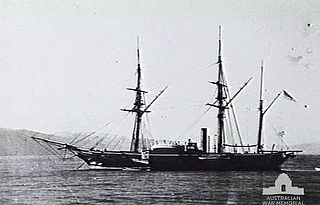
HMS Virago was a Royal Navy Driver-class wooden paddle sloop launched on 25 July 1842 from Chatham Dockyard.

HMS Katoomba was a Pearl-class cruiser built for the Royal Navy, originally named HMS Pandora, built by Armstrong Whitworth, Elswick, Tyne and Wear and launched on 27 August 1889. Renamed on 2 April 1890, as Katoomba as the flagship of the Auxiliary Squadron of the Australia Station. She arrived in Sydney with the squadron on 5 September 1891. She was damaged in a collision with the tug Yatala in Port Adelaide on 29 December 1891. She left the Australia Station on 16 January 1906. She was sold for £8500 on 10 July 1906 and broken up at Morecambe.

HMS Ringarooma was a Pearl-class cruiser of the Royal Navy, originally named HMS Psyche, built by J & G Thomson, Glasgow and launched on 10 December 1889. Renamed on 2 April 1890, as Ringarooma as part of the Auxiliary Squadron of the Australia Station. She arrived in Sydney with the squadron on 5 September 1891. She was damaged after running aground on a reef at Makelula Island, New Hebrides on 31 August 1894 and was pulled off by the French cruiser Duchaffault. Between 1897 and 1900 she was in reserve at Sydney. On 15 February Captain Frederick St. George Rich was appointed in command. She left the Australia Station on 22 August 1904. She was sold for £8500 in May 1906 to Forth Shipbreaking Company for breaking up.

HMS Tauranga was a Pearl-class cruiser of the Royal Navy. The vessel was originally named Phoenix and built by J & G Thomson, Glasgow. She was launched on 28 October 1889. Renamed on 2 April 1890, as Tauranga as part of the Auxiliary Squadron of the Australia Station. She arrived in Sydney with the squadron on 5 September 1891. During the Samoan civil unrest in 1899, she took part in operations with HMS Porpoise and HMS Royalist. Spending between 1901 and 1903 in reserve at Sydney before being assigned to the New Zealand division of the Australia Station. She left the Australia Station on 14 December 1904. She was sold for £8500 in July 1906 to Thomas Ward for breaking up.
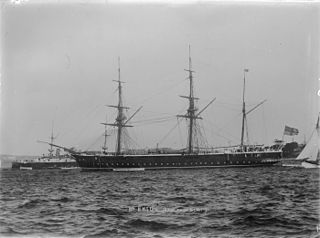
HMS Opal was an Emerald-class corvette of the Royal Navy, laid down as Magicienne by William Doxford & Sons Ltd, Sunderland and launched on 9 March 1875.
HMS Beagle was a schooner of the Royal Navy, built by John Cuthbert, Millers Point, New South Wales and launched in December 1872.

Mary Ann Kiliwehi Kaʻauwai was a Hawaiian high chiefess and lady-in-waiting of the Kingdom of Hawaii. Alongside her husband William Hoapili Kaʻauwai, she traveled with Queen Emma of Hawaii to Europe between 1865 and 1866, and circumnavigated the globe upon their return eastward via New Zealand.

Mary Ann Kinoʻole Kaʻaumokulani Pitman, later Mary Pitman Ailau, was a high chiefess of the Kingdom of Hawaiʻi of part Native Hawaiian and American descent. She was raised and educated in Hilo and Honolulu and served as a maid of honor and lady-in-waiting of Queen Emma, the wife of Kamehameha IV. In 1861, she left for the United States with her family, and she lived for the next twenty years in New England. She visited her distant cousin King Kalākaua during his state visit to the United States in 1875. She returned in 1881 to Hawaiʻi where she married musician John Keakaokalani Ailau, better known as Jack Ailau. In later life, she invested in Hawaiian curio shops selling artifacts of Hawaiiana; many of her collections are preserved in the Bernice Pauahi Bishop Museum.

Charles Gordon Hopkins (1822–1886) was a British-born politician and newspaper editor of the Hawaiian Kingdom. He served several posts in the Hawaiian government including Minister of Finance and Minister of the Interior. He became an intimate friend and advisor to three successive Hawaiian monarchs. From 1865 to 1866, he accompanied Queen Dowager Emma on her trip to Europe and the United States.
